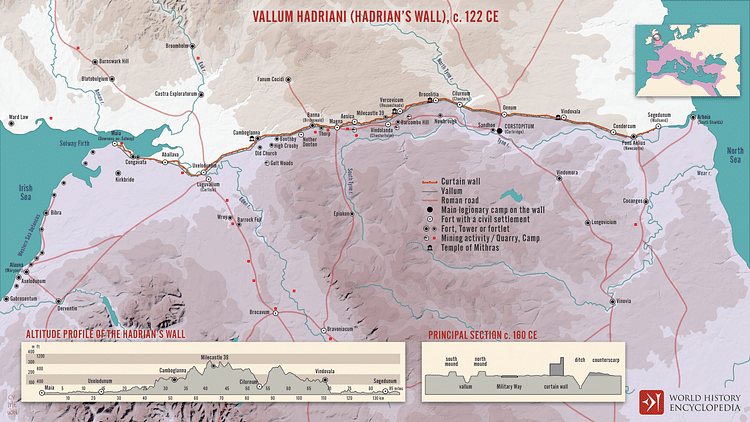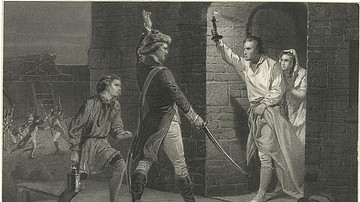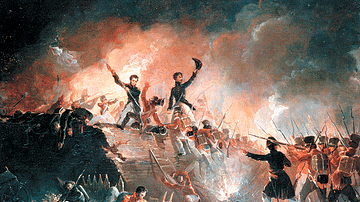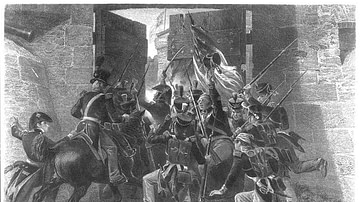The 1,900th anniversary of the visit of the Roman emperor Hadrian (r. 117-138 CE) to Britain and the construction of the wall that bears his name will be observed in 2022. A year-long festival will be held, filled with hundreds of events and activities across the length of Hadrian's Wall, a UNESCO World Heritage Site.

Hadrian's Wall is one of the most iconic sites in Northern England and annually attracts thousands of hikers and history fans along its 84-mile-long (135 km) National Trail. Stretching across the country from Wallsend on the River Tyne in the east to Bowness-on-Solway on the west coast, Hadrian's Wall is regarded as one of the Roman Empire's greatest engineering feats and a fascinating legacy left to Britain by Emperor Hadrian.
Hadrian's Wall formed the northwest frontier of the Roman Empire for over 300 years. As Hadrian's biographer put it in the Historia Augusta, the emperor "corrected many abuses and was the first to build a wall, 80 miles [128 km] in length, to separate the barbarians from the Romans" (Life of Hadrian, 11.2.) However, it was more than just a wall against raiders from the north. It was a cleverly designed active military line guarded by 15,000 troops, with a dense cordon of fortified gateways (milecastles) and observation towers (turrets), as well as a series of forts and massive earthworks (the vallum and the north ditch).

The cultural significance of Hadrian's Wall was recognised in 1987 when it became a UNESCO World Heritage Site. From 2005, it became part of the transnational Frontiers of the Roman Empire World Heritage Sites (currently comprising Hadrian's Wall, the German Limes, The Danube Limes, and the Antonine Wall), and in 2003, a designated National Trail was opened. Hadrian's Wall Path National Trail has become one of Britain's most popular long-distance paths, offering a unique mix of history and nature. It passes through some of the country's most beautiful countryside, following the landscape and taking full advantage of the natural barrier formed by crags, hills and rivers.
Whether you plan to walk a section or all of Hadrian's Wall, this guide will lead you to some of the best sights and help you plan an unforgettable journey along this historic route and archaeological treasure.
1. Housesteads Roman Fort & Surroundings
Housesteads (originally Vercovicium) is the best-known fort on Hadrian's Wall and the most popular monument along the wall line, with 100,000 visitors annually. The fort stands in splendid isolation, perched high up on the side of the hill, with spectacular views. It is also generally regarded as the finest and best-preserved of all the forts on Hadrian's Wall. It is the best place to see many of the original features of such military installations.

The forts of Hadrian's Wall followed the Roman army's traditional 'playing card' design – rectangular in shape, with rounded corners and four double-passage gates. Internally, it contained administrative and official buildings, barracks, and stores. At Housesteads, many of the internal buildings can be seen in detail, including the headquarters building (principia), the commanding officer's house (praetorium), barrack blocks, the hospital, latrines, granaries, and storerooms.

A small museum contains a fascinating collection of Roman finds from the site, including Roman altars, dedication stones, jewellery, tools and weapons, a sculpture of the winged goddess Victory, and a relief of the Genii Cucullati (Hooded Spirits), hooded Celtic deities associated with fertility and prosperity.
Immediately west of Housesteads Roman Fort is Milecastle 37 (Housesteads), with its well-preserved walls, internal rooms and the best extant example of a milecastle gate.
Walking west, visitors reach the top of Cuddy's Crags, where they can pause to look back towards Housesteads to see one of the most iconic images of Hadrian's Wall and the Northumberland National Park. From here, the view to the east captures the essence of Hadrian's Wall and nature with the snaking line of the wall and its setting of rocky crags.
Immediately east of Housesteads Roman Fort is Knag Burn Gateway, one of the few gates through the wall that was not part of a milecastle or fort. It was constructed to allow trade traffic through the wall when the north gate of the fort at Housesteads was closed. The trail heading eastwards brings us to Sewingshields Crags, a memorable panoramic spot, providing the last and perhaps finest view of the Whin Sill (geological feature) from the east. At the eastern end of the well-preserved central sector of Hadrian's Wall stand Sewingshields Turret (35a) and Milecastle 35, perched dramatically on the edge of a high rocky outcrop.

Facilities: on-site parking (charges apply), Housesteads Visitor Centre adjacent to the car park, cafeteria
2. Steel Rigg & Sycamore Gap
The stretch of wall from Steel Rigg to Sycamore Gap is the most popular and best photographed. The path runs along a series of dramatic crags, making it the most scenic section of Hadrian's Wall with one fabulously sited milecastle and the famous Sycamore Gap. The trail from Steel Rigg car park first takes us into Peel Gap, where a tower was constructed shortly after the wall had been completed. After a 15-minute walk, we encounter one of the iconic views of the wall overlooking Milecastle 39 (Castle Nick).
A little farther away and after a sharp descent, the wall comes to Sycamore Gap, named after the lone sycamore tree that stands there and immortalised by a scene in the blockbuster film Robin Hood: Prince of Thieves (1991). The tree's position in the landscape offers stunning scenery and is believed to be one of the most photographed trees in the country. In 2016, it won the England Tree of the Year award.
Facilities: Steel Rigg parking (charges apply)
3. Vindolanda Fort & Museum
Vindolanda was one of the Stanegate forts that pre-dated Hadrian's Wall. Constructed c. 85 CE and occupied until the end of Roman Britain, Vindolanda was the longest-occupied fort on the line of the wall. Located one mile south of Hadrian's Wall, Vindolanda offers a comprehensive view of a Roman fort and its civil settlement (vicus), supported by an excellent museum that gives a remarkable insight into garrison life on the wall.
The extensive site of Vindolanda comprises nine forts built on top of each other. The visible remains date to the 3rd century CE and include the fort walls, the headquarters building, the commanding officer's house, granaries and barracks, and the extramural settlement with houses, shops, a tavern and a bathhouse.
One magical window on the past has been revealed in the Vindolanda writing tablets, one of Britain's most important archaeological discoveries. Written in ink on postcard-sized pieces of wood, the tablets consist of private letters and military records, providing a glimpse into the daily life of the people living on the northern frontier in the years immediately before the construction of Hadrian's Wall (80-120 CE). New tablets continue to be found. A new cache of 25 tablets turned up in excavations in 2017, together with the only known pair of Roman boxing gloves.

One of the largest and longest-running excavations occurs at Vindolanda fort, with volunteers travelling from all over the world to participate. The excavation season starts in early April and continues until the end of September, allowing visitors to see the volunteer excavations in action.
Facilities: on-site free parking, cafeteria, museum
4. Chesters Roman Fort
Beautifully sited next to the River Tyne four miles north of Hexham, Chesters Roman Fort, known in Roman times as Cilurnum, was built to control the North Tyne crossing of Hadrian's Wall. It housed a garrison of 500 cavalrymen and was occupied for nearly 300 years until the end of Roman rule in Britain in the 5th century CE.

The exposed remains are the result of the excavations by antiquarian and collector John Clayton (1792-1890), who also played a significant role in preserving the remains of Hadrian's Wall. The visible buildings include the central headquarters building (principia), the commanding officer's house (praetorium), two opposing barrack blocks, and all four principal gates. The highlight is down by the river, where the best-preserved bathhouse on the frontier can be seen.
The Clayton Museum at Chesters houses a fabulous collection of inscriptions, altars, and sculptures from the fort and the surrounding areas.
Facilities: car park (charges apply), museum, cafeteria
5. Corbridge Roman Town
Corbridge is not on the wall but three miles (4.8 km) south on the Stanegate and was occupied longer than any other site along Hadrian's Wall. The first settlement was a fort established in the 80s CE to control the river crossing of the Tyne.
It later developed into one of Britain's most important Roman towns and the most northerly in the Roman Empire. The importance of Corbridge sprang from its position at the junction of the east-west Stanegate road that ran to Carlisle and north-south Dere Street, leading to London.
The ancient town of Coria (also known as Corstopitum) expanded to twelve hectares (29 acres), but only about one-tenth of the settlement has been excavated.
The remains visible today represent only a tiny fraction of the Roman town built around the site of successive forts, including the best-preserved granaries of Britain, a market complex, an ornate fountain, and compounds for legionary soldiers.
The site museum has one of the largest collections of artefacts from Hadrian's Wall, with over 34,000 finds, giving a vivid insight into life in the northernmost town of the Roman Empire.
Facilities: on-site free parking, museum
6. Birdoswald & Willowford
Birdoswald is the ideal place to visit to see one of the longest stretches of Hadrian's Wall, extensive remains of a Roman fort, milecastles, and turrets, and the remains of a Roman bridge. The site is set in stunning countryside with expansive views over the River Irthing.
Known as Banna to the auxiliary soldiers who garrisoned it 1,900 years ago, the Birdoswald fort is undoubtedly one of the best preserved of the 16 forts along Hadrian's Wall. The gates and outer walls of the fort are well laid out, as are the granaries and a building more convincingly interpreted as a drill hall. Most noteworthy are the impressive remains of the east gate, the best-preserved fort gateway on Hadrian's Wall.

East of Birdoswald, it is possible to walk over a mile along the wall, with two milecastles (Harrows Scar and Poltross Burn), two turrets (48b and 48a), and the remains of a ruined Roman bridge.
In the first stretch, a phallic symbol can be found on the south side of the wall before reaching Harrows Scar milecastle (49). From the milecastle, the path leads down to a modern footbridge crossing the River Irthing and the remains of the east abutment of a Roman bridge on the opposite bank, now lying on dry land. Another long stretch of wall runs towards Gisland and Poltross Burn milecastle (48).

Facilities: Biroswald car park (charges apply), visitor centre, museum, cafeteria
7. Temple of Mithras (Carrawburgh)
Religion played a significant role in Roman daily life. It was no different in Britain and on Hadrian's Wall. A secretive cult favoured by Roman army officers was particularly popular on the frontier: Mithraism, a religion that made its way to Britannia from the eastern empire and centred on worshipping the god Mithras.
Followers of Mithras worshipped in a dark, cavern-like temple known as a mithraeum. One such temple was excavated in 1950, just south of the course of Hadrian's Wall. Soldiers probably constructed the building from the opposite fort of Brocolitia (Carrawburgh) around 200 CE. The three altars found at the site (replicas stand in the temple) were dedicated by commanding officers from the fort's garrison of Batavian auxiliaries originally recruited from the Rhineland. One altar has a relief of Mithras wearing a radiate crown, the rays of which are pierced to allow light from an oil lamp placed within it to shine through.

Two other mithraea are known to have existed along Hadrian's Wall at Housesteads and Rudchester, but Carrawburgh's is the only one that can be visited today. The temples have yielded many artefacts relating to the worship of Mithras, and material from the mystery cult can be seen at Newcastle's Great North Museum: Hancock.
Facilities: Brocolitia car park (charges apply)
8. Great North Museum: Hancock
The Hadrian's Wall Gallery at the Great North Museum in Newcastle is an essential place to go to during your visit to the wall. The gallery houses an outstanding collection of Roman statues, altars, the inscription proving that the wall was built on orders of Hadrian, and a vast array of other artefacts. The Hadrian's Wall Gallery also includes a large-scale interactive model of the wall.

A new display is bringing Roman history back into colourful view. Seven Roman altars from Hadrian's Wall have come to life in vivid colours to show what they would have looked like 1,900 years ago using only projected light.
9. Cawfields
There were once 80 milecastles spaced approximately every Roman mile along the length of Hadrian's Wall. Cawfields Milecastle 42 is not the best-preserved milecastle, but it is impressively situated, hanging on to the edge of the Cawfields Crags.

Although most of the milecastles were built by legionaries, it was left to auxiliary soldiers to guard them. Each milecastle had barrack blocks that could accommodate up to 30 men who came from across the Roman Empire, from the regions of modern France, Belgium, Germany, Hungary, Syria and even North Africa.
To the south of Milecastle 42 is a fine stretch of the vallum, a massive earthwork that originally consisted of a broad flat-bottomed ditch six metres wide (20 ft) and three metres deep (10 ft), flanked by mounds to its north and south formed from the upcast. It was a physical obstacle but also marked the edge of Hadrian's Wall military zone. Soldiers regulated entry to this zone at vallum crossings. To the east, the wall runs past Thorny Doors, where it stands 13 courses high, to Caw Gap turret (41a).
Facilities: Cawfields Quarry car park (charges apply), public toilets
10. Benwell Temple & Vallum Crossing
Benwell, a suburb of Newcastle on Tyne near the eastern end of Hadrian's Wall, has two particularly interesting Roman structures hidden amid a 1930s housing estate: the Temple of Antenociticus and the only surviving crossing of the vallum.
A fort was established at Benwell (Condercum) to support the monitoring of Hadrian's Wall. It was occupied throughout most of the Roman period by a cavalry regiment. The fort itself is no longer visible, but 60 metres (196 ft) east, between two houses' gardens, stands a temple dedicated to an otherwise unknown Celtic deity, Antenociticus, which once stood outside the fort's civilian settlement (vicus).

The temple of Antenociticus in Benwell is a small apsidal building constructed by Roman officials and soldiers who also set up altars and a life-size cult statue of the god in the temple. One of the altars found at the site records the gratitude of a cavalry commander, Tineius Longus, for becoming a member of the Roman Senate. All the finds from the Temple of Antenociticus are displayed in the Great North Museum in Newcastle.
A fascinating feature of Hadrian's Wall that is only visible in Benwell is the crossing of the vallum. There were several stone-built causeways along the length of the wall where the road from the south crossed the vallum earthwork. Archaeological evidence of causeways has been found at Housesteads, Birdoswald, and Great Chesters, but the Benwell crossing is the only one still visible. A road linked this crossing with the south gate of the Condercum fort. There would have been an imposing arched stone gateway built on top of the causeway, with double wooden doors.
Nearby to the west, the first sighting of the wall and turret is located in Denton Burn and Denton Hall Turret, while the first significant section of the wall is at Heddon-on-the-Wall.
The ongoing celebrations marking the 1,900th anniversary of Hadrian's Wall make a great time to visit and hike its length. You can view all events and activities taking place until the end of 2022 here and follow the #HW1900 hashtag on social media platforms. For further information about walking Hadrian's Wall visit this site.
It takes six or seven days to tackle the whole path, and there is a Hadrian's Wall Path Passport scheme (May-Oct) involving collecting seven stamps to prove you made it. For people who want to walk only short routes, the AD122 Hadrian's Wall Bus runs hourly along Hadrian's Wall between mid-April and the end of October. PLEASE DO NOT stand or climb on Hadrian's Wall.
The Google map below has all the Hadrian's Wall locations mentioned in this article and many more. You will find additional photos, GPS coordinates, and links.















